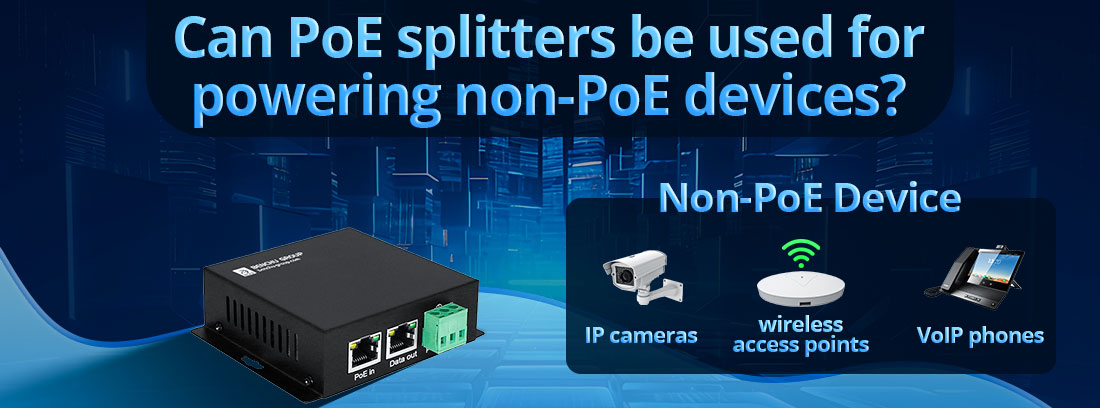
Sim, os divisores de poder sobre Ethernet (POE) podem ser usados para alimentar dispositivos não-POE. Um divisor POE é um dispositivo que separa a potência fornecida sobre um cabo Ethernet em linhas de dados e de dados separadas. Ele essencialmente permite que um dispositivo não POE seja alimentado através de um cabo Ethernet padrão, enquanto ainda é capaz de receber dados de rede. Aqui está uma quebra mais detalhada de como ele funciona:
Como os divisores de Poe funcionam:
1. Poe Power Deliver Poe Splitter.
2. Separação de potência e dados: o divisor POE pega o cabo Ethernet de entrada com potência e dados combinados e os separa. Ele extrai a potência, geralmente através dos 48V fornecidos pelo padrão POE e o converte em uma tensão mais baixa (por exemplo, 5V, 9V, 12V ou 24V, dependendo do modelo do divisor).
3. Dispositivos não-POE POE: Após a separação, o divisor de POE gera a energia convertida no dispositivo não-POE através do conector apropriado (normalmente um conector de barril ou, em alguns casos, uma porta USB). Ao mesmo tempo, ele passa os dados de rede pelo dispositivo não-POE através da porta Ethernet.
Casos de uso para divisores de POE:
--- Dispositivos não-POE: Esses divisores são comumente usados quando você possui dispositivos não-POE, como câmeras IP, telefones VoIP, pontos de acesso sem fio ou outros dispositivos de rede que não suportam nativamente PoE, mas ainda precisam ser alimentados remotamente .
--- Elimine a necessidade de linhas de energia separadas: uma das principais vantagens é a capacidade de eliminar a necessidade de uma linha de energia dedicada a esses dispositivos não POE, reduzindo a complexidade da instalação, o custo e a desordem de cabo.
Limitações:
--- Distância: A distância máxima para alimentar o dispositivo é restringida pelas limitações do cabeamento Ethernet e pela energia fornecida pela fonte POE. Normalmente, para POE padrão (IEEE 802.3AF), a energia é limitada a cerca de 15,4w e, para PoE+ (IEEE 802.3AT), pode subir até 25,5w. Para distâncias mais longas, você pode precisar de padrões de energia mais altos como o IEEE 802.3bt (Poe ++).
--- Requisitos de energia: Nem todos os divisores de POE suportam todos os requisitos de tensão para todos os dispositivos não-POE. É importante garantir que a saída de tensão do divisor seja compatível com as necessidades do dispositivo que você está ligando.
Cenário de exemplo:
--- Se você estiver configurando uma rede de câmeras IP e algumas das câmeras não suportam o POE, poderá usar o POE Splitters para alimentar essas câmeras sem precisar executar um cabo de alimentação separado. O injetor POE conectado ao seu comutador enviará dados e energia através do cabo Ethernet. O divisor Poe --- na extremidade da câmera extrairá e converterá a energia na tensão necessária, permitindo que a câmera opere enquanto ainda mantém uma conexão de dados.
Em resumo, os divisores de POE são uma solução eficiente e prática para alimentar dispositivos não-POE usando uma infraestrutura Ethernet existente, economizando tempo e dinheiro em cabeamento adicional de energia. No entanto, é essencial corresponder aos requisitos de tensão e energia do dispositivo com as especificações do divisor.